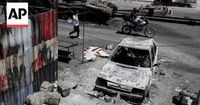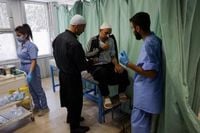The stench of death still hangs heavy over Sweida, a city in southern Syria, where violent sectarian clashes erupted nearly two weeks ago, leaving a trail of destruction and despair. Once lively streets now lie silent and deserted, with charred buildings and burned-out cars standing as grim reminders of the recent bloodshed that has shattered this fragile corner of Syria.
The violence, which began around July 13 and 14, 2025, was sparked by tit-for-tat kidnappings between armed Bedouin clans and fighters from the Druze religious minority, escalating into brutal fighting that claimed the lives of hundreds. According to the Syrian Network for Human Rights, at least 903 people have died, though the toll is expected to rise as the situation remains volatile. This sectarian strife has not only torn apart communities but also threatened to unravel Syria's delicate postwar transition.
Syrian government forces intervened ostensibly to restore order, but reports indicate they sided with the Bedouin clans, with some government fighters accused of robbing and executing Druze civilians. An emergency room nurse, who identified herself only as Em Hassib, alleged that government fighters brought to the hospital for treatment opened fire, killing a police officer guarding the facility and wounding another. Though these claims could not be independently verified, they paint a troubling picture of chaos within an already overwhelmed healthcare system.
The main hospital in Sweida has been pushed to its limits, grappling with a surge of trauma patients amidst severe shortages of electricity, water, and essential medicines. The World Health Organization's Christina Bethke described the situation as "grim," highlighting that many medical staff struggle to reach the hospital safely, and that the mortuary was overwhelmed, with bodies piling up and posing a serious health hazard.
Among the wounded is 19-year-old Safi Dargham, a first-year engineering student who was shot multiple times while volunteering at the hospital. His mother, Manal Harb, recounted the harrowing moment: "Snipers hit him in front of the hospital. We are civilians and have no weapons." Safi faces the possibility of losing his arm due to the severity of his injuries. His father, Khaled Dargham, was tragically killed when armed men stormed their home, shooting him before setting the house ablaze and stealing their belongings.
The violence has deeply fractured the Druze community, an offshoot of Ismailism within Shiite Islam, which numbers roughly one million worldwide, with over half residing in Syria. The Druze have long been a minority navigating the complex sectarian landscape of the region. The recent clashes saw disturbing videos emerge of Druze civilians being humiliated and executed, sometimes accompanied by sectarian slurs, while some Druze groups retaliated with revenge attacks against Bedouin communities after a ceasefire was established.
Interim President Ahmad al-Sharaa, a former Islamist commander with past ties to al-Qaida, has promised accountability for those targeting civilians. However, many residents remain skeptical and angry. Al-Sharaa denies targeting the Druze and blames the unrest on armed groups loyal to Sheikh Hikmat al-Hijri, the Druze spiritual leader who opposes the current government. He also accuses Israel of stoking divisions by striking Syrian forces in Sweida under the pretext of defending the Druze.
Talal Jaramany, a 30-year-old Druze resort owner who took up arms during the fighting, voiced a sentiment shared by many in his community: "What pushed me to put on a military uniform and go to the front lines is that what happened was lawless. They used weapons, not dialogue." He firmly rejects calls for disarmament, stating, "We won’t hand over our arms. Our weapon is sacred. It’s not for attacking. We’ve never been supporters of war. We’ll only give it up when the state provides real security that protects human rights."
The conflict has not spared other minorities in Sweida. Members of the Christian community, too, have endured near-death experiences. Walaa al-Shammas, a 36-year-old housewife with two children, recalled how a rocket struck her home on July 16, destroying it and their vehicles. Gunmen later came to the house but left, apparently believing it was empty as the family hid in a hallway.
As the violence raged, hundreds of people from Bedouin, Druze, and Christian communities were forced to flee. The Syrian Red Crescent organized convoys to evacuate many to safer areas, while others escaped on their own. Among the survivors is Micheline Jaber, a public employee who was wounded while fleeing with her family. Tragically, her husband and several relatives were killed in shelling during their escape. She was rescued and transported to hospitals in Daraa and Damascus and now recuperates in a Damascus suburb. Reflecting on her survival, Jaber said, "When you see all the people who died and I’m still here, I don’t understand it. God has His reasons. My daughter is the most important thing and she is what gives me strength."
The United Nations reports that more than 145,000 people have been displaced by the recent fighting, many of whom are sheltering in makeshift reception centers in Daraa and Damascus. Humanitarian access remains challenging, with ongoing tensions between various armed groups controlling different parts of the Sweida governorate.
As Sweida struggles to heal, the scars of sectarian violence linger in its streets and hearts. The fragile ceasefire offers a glimmer of hope, but the deep mistrust and unresolved grievances among communities pose significant obstacles to lasting peace. The question remains: can Sweida rebuild its shattered peace, or will the wounds of this bloodshed continue to fester?


